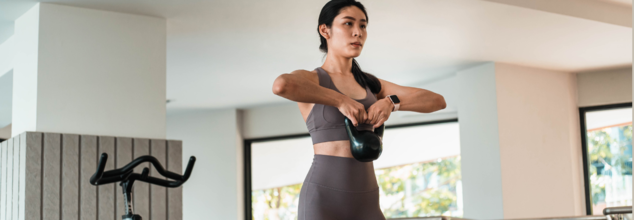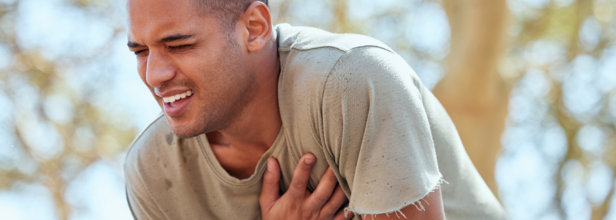
Credits: Canva
This 15-Minute Workout 3 Times A Week Can Make Look 8 Years Younger
Aging gracefully is something we all want, but what if science said it told you that you don't just have to look and feel younger based on skincare or supplements—but maybe actually starts in the weight room? A new study out in the journal Biology shows that doing a mere 15 minutes of strength training, three times a week, can make your biological age drop up to 8 years.
While exercise has been widely championed for keeping us healthy and robust, this new study illuminates its underlying impact on cellular aging, presenting a strong argument for adding short, intense workouts to your routine.
Carried out on almost 4,900 American adults, the research investigated the connection between strength training and telomere length—those little protective caps on our chromosomes that naturally get shorter as we get older. Telomeres are one of the most precise indicators of biological age. The shorter they are, the older your body feels and acts.
Scientists discovered that those who took part in frequent strength training had much longer telomeres, independent of considerations like age, sex, race, income, smoking status, body size, or other physical activity levels.
Here's what was surprising:
- Each 10 minutes of strength training per week was linked with slightly longer telomeres.
- Those who worked out 90 minutes of strength training per week had biological ages almost 4 years younger.
- Those who trained for 180 minutes per week experienced a decrease equivalent to 8 years of biological aging.
The moral? Only 45 minutes of strength training over three days a week can reverse your body's clock.
How Strength Training Affects Biological Age?
The benefits of strength training extend far beyond defined arms and better posture. On a cellular level, this type of exercise actually works to repair and rebuild your body. Researchers say resistance exercises can even slow the aging process by:
- Lowering risks for chronic disease (such as diabetes and heart disease)
- Increasing resting metabolic rate
- Encouraging fat loss and muscle gains
- Enhancing cardiovascular function and insulin sensitivity
- Increasing overall strength and mood stability
As muscle mass loses strength with age—a phenomenon termed sarcopenia—strength training acts as an antidote, postponing or mitigating the process.
Why 15 Minutes Can Have Such a Difference?
You don't require prolonged visits to the gym or elaborate apparatus to enjoy the benefits. The study highlights consistency as superior to intensity or frequency. Three visits per week to the gym of 15-minute duration can tally up to radically different results, provided muscle stimulation and technique are the areas of focus.
This leaves the door open for working professionals, parents, and seniors to gain benefits without radically changing their routines. The message is straightforward: a little does a lot.
Current Physical Activity Guidelines: Are You Doing Enough?
The Physical Activity Guidelines for Americans suggest:
- A minimum of 150 minutes of moderate-intensity aerobic physical activity per week
- Two or more days a week of muscle-strengthening activities
This study not only confirms those suggestions but stresses that strength training, even in brief intervals, is a key factor in cellular youthfulness and disease prevention.
Ways to Fit in 15 Minutes of Strength Training Daily
You don't have to go to a gym to turn back your biological clock. Here are realistic ways to incorporate strength training into your daily routine:
- Bodyweight exercises: Squats, push-ups, lunges, and planks
- Resistance bands: Inexpensive and portable
- Home dumbbell sets: Compound movements such as rows and shoulder presses
- Step-ups or stair climbing: Leg strength with a boost of cardio
- Pilates or barre class: Core strengthening and increased flexibility
- Guided online workouts: Utilize free or paid platforms for formatted 15-minute sessions
- Mini circuits: Alternate 3–4 strength exercises with brief rest periods
This research contributes to the mounting evidence that aging isn't all about genetics—it's about lifestyle. Small, regular habits such as strength training for only 15 minutes a day can do more than make you look fit—they can actually make your cells feel younger.
So whether you're 30, 50, or beyond, now's the time to grab a resistance band, drop into a squat, or lift a weight—and start turning back the clock. By doing just 45 minutes of strength training a week, you're not only changing your body, you're updating your body's inner blueprint. And that's an investment in fitness worth making.

Credits: Canva
Can You Be Fit And Still Be At Risk Of A Cardiac Arrest?`
In a shocking incident, an Air India Express pilot in his 30s collapsed and died of cardiac arrest shortly after successfully landing his flight from Srinagar to Delhi. According to reports, he vomited in the cockpit and later passed away. The tragedy has turned the spotlight on the rising cases of sudden cardiac arrest (SCA) among seemingly healthy young adults—especially professionals in high-stress jobs.
Fit But Vulnerable: Why It Still Happens
It’s easy to assume that physically fit individuals are protected from heart trouble, but fitness isn’t always a shield against cardiac events. Sudden cardiac arrest doesn’t necessarily require years of poor lifestyle choices or obvious health issues.
Unlike a heart attack, which is caused by a blockage in blood flow to the heart, SCA occurs when the heart’s electrical system malfunctions, often due to irregular heartbeats or arrhythmia. In many cases, a heart attack can also trigger a cardiac arrest if it interferes with the electrical activity of the heart.
So why is this happening to young adults, especially those in their 30s?
Stress, Sleep, and the Hidden Risks
Jobs with erratic schedules—like those of pilots, doctors, or corporate professionals—can strain the heart over time, especially when chronic stress and poor sleep are involved. When you're stressed, your body releases hormones like adrenaline and cortisol, which increase your heart rate and blood pressure. If this continues over time, the heart muscle can weaken or develop rhythm issues.
In this case, the pilot reportedly vomited before collapsing—this could be linked to the vagus nerve, which connects the brain and the heart. During cardiac stress, the body can misinterpret reduced blood flow as a stomach issue, leading to nausea or vomiting.
Conditions like stress cardiomyopathy—a temporary weakening of the heart triggered by intense emotional or physical stress—can also interfere with heartbeat regulation, leading to SCA even in the absence of blocked arteries.
Why Your 30s Are Not “Too Early” for Heart Trouble
Studies are beginning to confirm what doctors have noticed in clinics: cardiac risks are increasing among the young. A 2023 study published in Circulation noted that people in their 30s are increasingly experiencing heart-related emergencies, and lifestyle factors are a major contributor.
This includes smoking, excess alcohol, recreational drug use, and even overuse of energy drinks, which overstimulate the heart. Dehydration, often overlooked, also plays a role—it can cause an electrolyte imbalance (especially sodium and potassium), which is crucial for steady heart rhythms.
Should Frequent Flyers Be Worried?
Frequent flyers or those working in aviation should be mindful. Long-haul flights, changing time zones, and limited movement all contribute to cardiovascular stress. The solution? Stay hydrated, move regularly during flights, and monitor any pre-existing conditions. Keeping medication in hand baggage and avoiding heavy meals, alcohol, or caffeine mid-air is also key.
Preventing the Worst: What You Can Do
Cardiac events don’t wait till your 50s. Experts now recommend heart screening from age 25 onward, especially if there’s a family history or stressful lifestyle. Regular exercise, a balanced diet, hydration, and stress-management routines—such as yoga, meditation, or even tech breaks—are more important than ever.
And yes, good sleep matters just as much as your gym routine. A rested body can recover from stress better—and so can your heart.

(Credit-Canva)
Walking Like This Helps You Burn More Calories!
Walking is one of the best exercises you can do. It engages all your important muscles and helps you burn a lot of calories. It is one of the most accessible forms of exercise that is great for beginners. There are also many ways that you can increase how many calories you burn. One such variation is the Nordic walking. Harvard Health Publishing tells us that Nordic walking is like taking your regular walk and adding a boost with special poles. This exercise was originally created for cross-country skiers to keep up their training during the summer months when there's no snow.
You can say it is similar to cross-country skiing but with no ice and on solid ground! Now, it's become a popular activity for everyone, especially older adults. It's a great way to get moving and get some fresh air, you may think using that the poles people are using is to support themselves, but these poles are meant to mimic the ski poles that boost you on the snow, these poles helps you engage more muscles than just regular walking, turning a simple stroll into a full-body workout. It's easy to learn and can be done almost anywhere.
Why It's Good for You?
Nordic walking is fantastic because it works both your heart and your muscles. It's like getting two workouts in one. Harvard Health Publishing explains that when you walk normally, you mostly use your leg muscles. However, when you add the poles, you start using your arms, shoulders, and core too. This means you're burning more calories, which is great for weight management. It also helps improve your heart health by increasing your heart rate. Plus, it can lower your bad cholesterol and raise your good cholesterol, which is good for your arteries. Nordic walking can also make you feel better mentally by reducing stress and anxiety. Furthermore, because the poles help with balance, you're less likely to fall, which is especially important as you get older.
How Can You Get Started?
To start Nordic walking, you'll need a pair of special poles. These aren't the same as regular hiking poles. Nordic walking poles have a special strap that fits around your wrist like a glove, which helps you push yourself forward. You can find these poles at most sporting goods stores or online. Once you have your poles, you can start practicing the techniques. There are two main techniques: double poling and single poling. Single poling is easier to learn, so it's a good place to start. Just swing one pole at a time, matching the movement of your legs. As you get better, you can try double poling, where you plant both poles at the same time.
The good news is that almost anyone can try Nordic walking. It's a low-impact exercise, which means it's gentle on your joints. Even if you have balance problems, the poles can actually help you feel more stable. However, it's always a good idea to talk to your doctor before starting any new exercise program, especially if you have any health conditions. Once you have your doctor's approval, you can choose a place to walk. You can walk on sidewalks, trails, or in parks. Just make sure the surface is relatively even and safe. You can even join a Nordic walking group, which is a great way to meet new people and stay motivated.

(Credit-Canva)
Sitting For Elongated Hours? Yoga To Relieve Lower Back Pain
Yoga is one of the best ways to ensure your body’s well-being. Whether you are trying to build muscle, increase your flexibility or relieve pain, yoga helps. The stretches and poses in yoga can help you work all your muscles as well as joints. One of the most popular ones are back exercises.
There are many reasons why your back may be hurting. With people spending more hours sitting on desks, whether it is for their jobs, studying etc. When you exercise your back, not only will you strengthen your back muscles, but you will also strengthen your core. Weak core muscles can also contribute to back pain during everyday activities. Medical experts agree that any exercise that strengthens the core is beneficial for lower back pain. While studies suggest yoga isn't significantly superior to other forms of exercise and stretching, it may offer long-lasting pain relief.
Downward-Facing Dog
This classic pose stretches and strengthens almost all muscles, relieving pressure on the spine and easing back tension. Start on hands and knees, lift knees off the floor, and raise your tailbone towards the ceiling, pressing into your hands. For a deeper lower back stretch, bend your knees and lengthen your tailbone upwards.
Child's Pose
Despite appearing restful, Child's Pose effectively stretches the back and hip muscles. It's also a great way to de-stress, especially before bed. Begin on hands and knees, bring big toes together, widen knees, and press hips back towards heels. Walk arms forward, resting forehead on a block, folded arms, or the mat, allowing shoulders to soften.
Reclined Half Pigeon
This variation of Pigeon Pose stretches the hip rotators and flexors. Tight hips can contribute to lower back pain, making this stretch beneficial. Lie on your back with bent knees, cross your left ankle over your right thigh, and thread your left arm through the leg triangle. Hold your right shin or hamstring with both hands, flex both feet, and hug legs towards your body, breathing into hips and lower back.
Triangle Pose
Triangle Pose effectively stretches both the hips and the spine. Facing the long edge of your mat, extend arms to a T and step feet wide. Turn your right toes to the top of the mat and angle your left foot slightly inward. Engage your core as you reach your right arm and torso forward, placing your right hand on the ground or a block outside your right ankle. Extend your left arm straight up, gazing towards your left thumb or straight ahead.
Cat-Cow Pose
Moving between Cat and Cow stretches the back muscles, lengthening and increasing the spine's flexibility. Start on hands and knees, aligning hands under shoulders and knees under hips. Tuck toes for stability and engage your lower abdomen. Inhale, relax your belly down, draw shoulder blades together to open your chest, and lift your gaze into Cow Pose. Exhale, arch your back into Cat Pose, pressing the ground away and tucking your chin to your chest.
Standing Forward Bend
This pose stretches the hamstrings and back muscles. Stand with feet shoulder-width apart and knees loose. Exhale as you hinge at your waist and bend forward, reaching towards the floor. Bending your knees helps lengthen the lower back and deepen the stretch in the legs. Hold for 10 to 20 breaths and repeat as needed.
Low Cobra
Low Cobra helps strengthen the back muscles, promoting healthy lower back alignment and body awareness. Lie on your stomach with forehead on the mat, slide palms back to align thumbs with lowest ribs, and press down through the tops of your feet. Inhale, engage your back body, and curl your chest up, pressing palms into the mat and drawing shoulder blades down and in. Hold for one to five breaths and repeat two to three times.
© 2024 Bennett, Coleman & Company Limited

